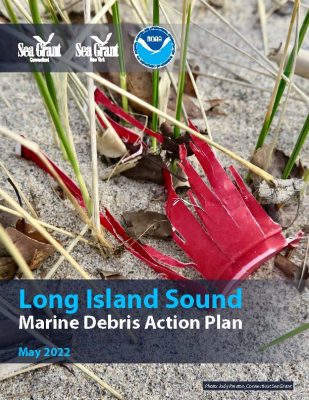 Consumer litter, tiny plastic shards, lost or improperly discarded fishing gear and other trash will be more effectively removed or kept out of Long Island Sound under the Marine Debris Action Plan completed this month.
Consumer litter, tiny plastic shards, lost or improperly discarded fishing gear and other trash will be more effectively removed or kept out of Long Island Sound under the Marine Debris Action Plan completed this month.
The 38-page plan, released on May 19, was created through a two-year process under the leadership of the Connecticut and New York Sea Grant programs with support from the National Oceanic and Atmospheric Administration (NOAA) Marine Debris Program. The project brought together almost four dozen state, local, academic and community partner groups interested in marine debris reduction in the two states that share the Sound. Together they developed a comprehensive framework to address the problem through collaborative solutions carried out over the next five years.
“Facilitating the development of this plan was a great opportunity to work with more than 75 people from different agencies and organizations who are already taking action to reduce the presence and impacts of marine debris in the Sound,” said Nancy Balcom, associate director of Connecticut Sea Grant and co-lead of the project. “This plan will enable us to better assess and share our collective progress in achieving our stated goals.”
New York Sea Grant Associate Director Katherine Bunting-Howarth served with Balcom as co-lead of the project.
“I’m excited to see how the collaborative efforts of the partners involved will achieve the plan’s goals and protect our aquatic resources,” Bunting-Howarth said. “Marine debris is a major concern along the coasts and in our oceans. Sources are many and enter our waters through upstream creeks and rivers as well as coastal waters.”
The plan organizes goals, strategies and actions intended to realize a vision of “Long Island Sound, its coast and watersheds, people and wildlife free of marine debris and its impacts.” These impacts include harm to coastal and marine habitats and organisms, economic losses, spread of invasive species and damage to vessels, among others. The plan is structured under three categories: Single-Use Plastic and other Land and Water-based Consumer Debris; Abandoned and Lost Fishing and Aquaculture Gear; and Microplastics and Microfibers.
Each action directed by the plan will be tracked and monitored with specific metrics and updated as new situations arise. The actions include public education efforts, behavior change campaigns, prevention policies and improved recycling and waste collection, among many others.
“We are pleased to support this collaborative initiative,” said Demi Fox, coordinator for the NOAA Marine Debris Program’s Northeast Region. “The Long Island Sound Marine Debris Action Plan facilitates partnerships between organizations and agencies in different sectors and different states, which is critically important in addressing and preventing marine debris.”
Contacts:
Connecticut Sea Grant Associate Director Nancy Balcom: Nancy.balcom@uconn.edu; Communications Coordinator Judy Benson: judy.benson@uconn.edu; (860) 287-6426
New York Sea Grant Associate Director Katherine Bunting-Howarth: keb264@cornell.edu, (607) 255-2832
More information:
CT Sea Grant: https://seagrant.uconn.edu/?p=8570
NY Sea Grant: www.nyseagrant.org/marinedebris
Long Island Sound Marine Debris Action Plan